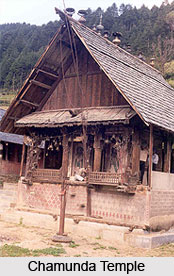 The temples of Chamba District have been mostly built by the enlightened and religious rulers of Chamba. Raja Meru Varman flourished near about A.D. 700. The earlier king Maru Varman could be described as the historical predecessor of Meru Varman and he founded the town of Brahmapura and made it the capital of the new State. Meru Varman later extended the limits of the state by conquests. In gratitude of his conquests inscriptions have been engraved of Meru Varman at Chatrari dedicated the idol of Shakti Devi. Another inscription recorded by a feudatory of Meru Varman, named Ashadha can be seen at Gun village.
The temples of Chamba District have been mostly built by the enlightened and religious rulers of Chamba. Raja Meru Varman flourished near about A.D. 700. The earlier king Maru Varman could be described as the historical predecessor of Meru Varman and he founded the town of Brahmapura and made it the capital of the new State. Meru Varman later extended the limits of the state by conquests. In gratitude of his conquests inscriptions have been engraved of Meru Varman at Chatrari dedicated the idol of Shakti Devi. Another inscription recorded by a feudatory of Meru Varman, named Ashadha can be seen at Gun village.
Temples built by Chamba Rulers
The Chamunda Temple at Devi Kothi, in Himachal Pradesh was built by Raja Umed Singh in 1754 A.D. the temple is important for the influence of the Mughal Dynasty in its structural patterns and in wood carving. The same influence can be depicted in some of the profane buildings of that period, like the State Kothi at Brahmaur ascribed to Raja Prithi Singh. The building was however destroyed in the earthquake on 4th April, 1905. Specimens of modern wood-carvings can be seen at Mindal, opposite Sach, on the temple of Chamunda (commonly called Mindal Devi) and on the little Naga temple near Kilar.
Meru Varman had extended his sway to Kullu State. One can see a long inscription on the pedestal of the brazen Nandi bull in front of the Mani Mahesa temple. Apart from these there are other two inscriptions in the temple of Lakshana Devi and Ganesa that ascribe the dedication of the idols to King Meru Varman. The temple known as Suraj-Mukha shrine contained the patron deity of Chamba Raja. This temple was also built by Meru Varman.
Sahila Varman another king of Chamba founded the new capital town of Chamba and shifted the capital there. He had sacrificed his daughter Champavati which is commemorated by the Chamasni temple erected by the king. The annual Suhi Mela is also celebrated to commemorate the sacrifice of Champavati. During the fair women assemble to sing her glory, devotion and sacrifice. The annual mela is celebrated for about twenty-one days from the 1st to the 21st Baisakh. This celebration has made the temple popular among the people. Sahila Varman is also credited with building few more temples as well as the original palace at Chamba.
The rulers of Chamba are also remembered for their patronage of the artists who excelled in the art of wooden architecture and Paharia-paintings on the walls and roofs. Apart from the paintings on the walls or ceilings of the temples there are many other old paintings on mythological and other subjects at the Bhuri Singh Museum.
There are also portraits and miniature paintings. Some of the rooms in the palaces have still wonderful decorations with oil paintings on the walls. It appears that when the artists had to leave Delhi, Agra and other places better known for art due to persecution of some of the Mughal Kings these smaller ruling princes in Himachal area gave them shelter and patronage. For our purposes only a mention to the wall paintings etc., as decorations on temples or other places is necessary as mostly the themes are old religious stories, mythological tales, shikhar and love dalliances of Lord Krishna, Radha and gopinis etc.











